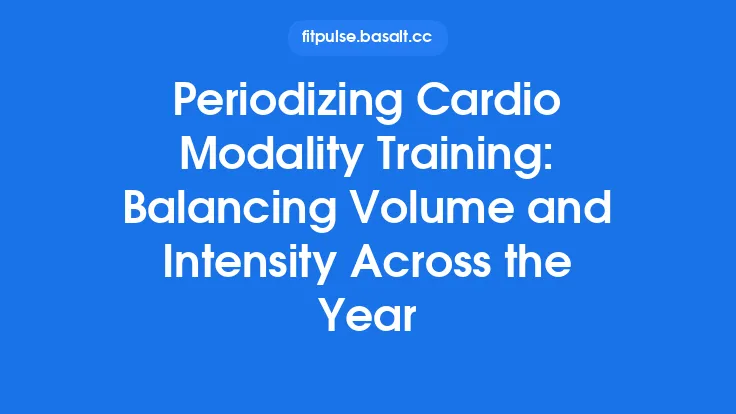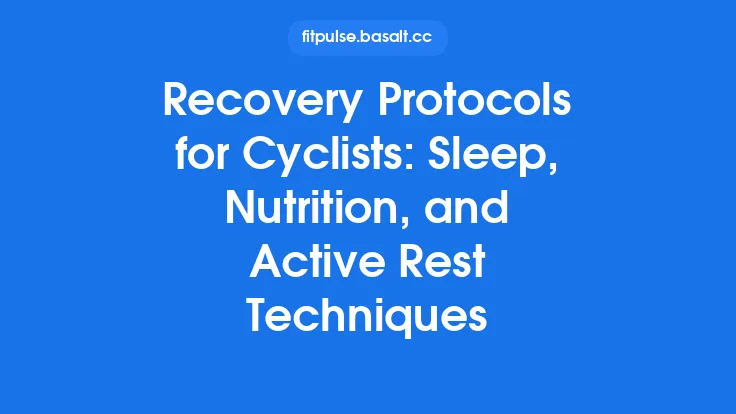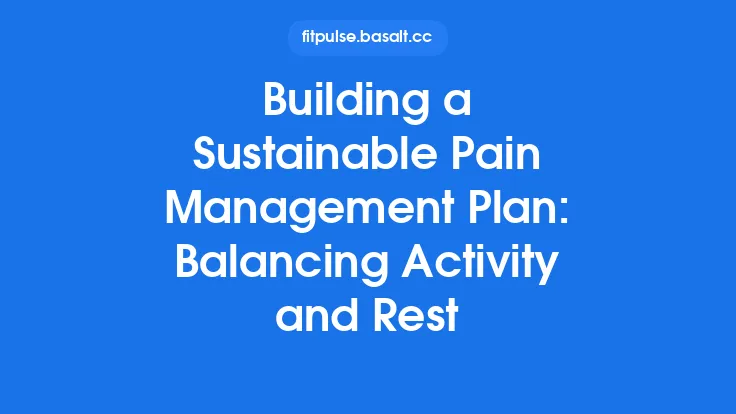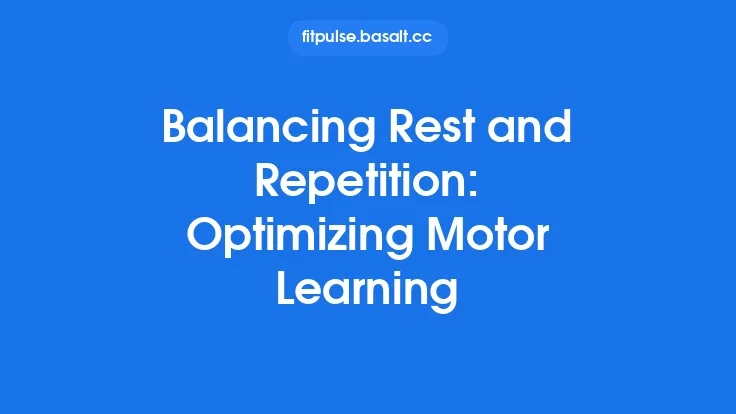Returning to sport after an injury is a delicate dance between two opposing forces: the need for tissue healing and the drive to regain performance. While the excitement of getting back on the field can tempt athletes and coaches to push harder, too much activity too soon can undo weeks or months of rehabilitation and set the stage for a new injury. The art of balancing rest and activity lies in understanding how the body responds to stress, structuring training so that each session builds on the last without exceeding the tissue’s capacity, and continuously fine‑tuning the plan based on real‑time feedback. Below is a comprehensive guide that walks through the science, the practical considerations, and the tools you can use to keep the return phase safe, efficient, and sustainable.
Understanding the Physiological Basis of Rest and Activity
1. Tissue Healing Phases
- Inflammatory Phase (0‑7 days) – Blood flow, cytokine release, and cellular debris removal. Rest is paramount; any mechanical load beyond gentle range‑of‑motion work can exacerbate inflammation.
- Proliferative Phase (7‑21 days) – Fibroblasts lay down collagen, angiogenesis peaks, and the extracellular matrix begins to gain tensile strength. Controlled, low‑intensity loading stimulates proper collagen alignment.
- Remodeling Phase (3‑12 weeks and beyond) – Collagen fibers mature, cross‑link, and align along lines of stress. Progressive mechanical stress is essential to convert the scar tissue into functional, load‑bearing tissue.
2. The Stress‑Recovery Cycle
Every training stimulus creates micro‑damage that the body repairs during subsequent rest. The net gain (supercompensation) occurs only if the rest interval is sufficient for the repair processes to complete. Too short a rest leads to cumulative fatigue; too long a rest results in detraining.
3. Hormonal and Cellular Signals
- Anabolic hormones (testosterone, IGF‑1) rise during recovery periods, especially after sleep and nutrient intake.
- Catabolic hormones (cortisol, catecholamines) dominate during prolonged stress, suppressing protein synthesis and impairing collagen formation.
Balancing these hormonal environments through appropriate rest and activity is a cornerstone of re‑injury prevention.
The Role of Adaptive Stress and the Principle of Supercompensation
Adaptive Stress is the intentional, measured load placed on a recovering tissue to provoke a beneficial adaptation. The magnitude, frequency, and type of stress must be calibrated to the tissue’s current healing stage.
Supercompensation Curve
- Baseline – Tissue at pre‑injury functional level.
- Stress Application – Training session introduces controlled load.
- Depletion – Immediate fatigue and temporary performance dip.
- Recovery – Rest period where repair mechanisms dominate.
- Supercompensation – Performance exceeds baseline if recovery was optimal.
If the next stress occurs before the recovery window closes, the curve collapses into a net loss, increasing re‑injury risk. Conversely, waiting beyond the supercompensation window leads to a plateau or decline, wasting valuable training time.
Designing a Balanced Return Phase: Key Components
| Component | What It Looks Like | Why It Matters |
|---|---|---|
| Micro‑Periodization | Split the return phase into 1‑week “micro‑cycles” with 2–3 low‑intensity sessions, 1 moderate session, and 3–4 rest days. | Provides predictable stress‑recovery rhythm, allowing tissue to adapt without overload. |
| Load Variation | Alternate between concentric‑dominant, eccentric‑dominant, and isometric drills. | Different contraction types stress tissues in unique ways, promoting comprehensive remodeling. |
| Movement Quality Emphasis | Prioritize technique, joint alignment, and neuromuscular control before adding speed or load. | Poor mechanics amplify shear forces on healing structures, raising re‑injury odds. |
| Gradual Volume Expansion | Increase total work (sets × reps × load) by ≤10 % per week, not per session. | Keeps the cumulative stress within the tissue’s adaptive capacity. |
| Strategic Rest Days | Schedule at least 48 h of complete rest after any session that includes high‑intensity or high‑volume work. | Allows inflammatory mediators to clear and anabolic processes to dominate. |
Integrating Active Recovery Strategies
Active recovery is not “rest” in the traditional sense; it is low‑intensity movement that promotes circulation, clears metabolic waste, and maintains neuromuscular readiness without imposing significant mechanical strain.
- Low‑Intensity Aerobic Work – Light cycling, swimming, or brisk walking at 40‑50 % of maximal heart rate for 15‑30 minutes.
- Mobility Drills – Dynamic stretches that move joints through safe ranges, focusing on the injured area’s surrounding musculature.
- Neuromuscular Activation – Light proprioceptive exercises (e.g., balance board, single‑leg stance) to re‑engage the central nervous system without loading the tissue.
- Contrast Therapy – Alternating warm and cool water immersion can enhance blood flow and reduce lingering edema.
These modalities can be slotted on “rest days” to keep the athlete moving without jeopardizing healing.
Monitoring Subtle Indicators of Overload
While sophisticated metrics (e.g., HRV, GPS load) belong to a different article series, coaches and athletes can still rely on simple, observable cues:
- Pain Patterns – New or worsening pain during or after a session, especially if it lags behind the activity.
- Joint Stiffness – Persistent morning stiffness that does not resolve after a warm‑up.
- Performance Drop – Sudden decline in speed, power, or coordination that cannot be explained by fatigue alone.
- Mood & Motivation – Uncharacteristic irritability or lack of enthusiasm may signal systemic stress.
- Sleep Quality – Difficulty falling asleep or frequent awakenings often precede overtraining.
When any of these signs appear, the safest response is to reduce load or add an extra rest day before progressing further.
Optimizing Sleep, Nutrition, and Hydration for Tissue Healing
Sleep
- Aim for 8‑10 hours of uninterrupted sleep per night.
- Prioritize deep‑sleep phases (stage 3) where growth hormone peaks, driving collagen synthesis.
- Create a consistent bedtime routine and limit blue‑light exposure in the evening.
Nutrition
- Protein: 1.6‑2.2 g/kg body weight daily, distributed across 4‑6 meals to sustain amino‑acid availability.
- Collagen‑Supporting Nutrients: Vitamin C (≥500 mg/day), zinc, and copper are co‑factors for lysyl‑oxidase, the enzyme that cross‑links collagen fibers.
- Anti‑Inflammatory Foods: Omega‑3 fatty acids (EPA/DHA), curcumin, and polyphenol‑rich fruits help modulate the inflammatory response without blunting necessary healing signals.
Hydration
- Maintain urine color between pale yellow and clear.
- Replace electrolytes lost through sweat, especially sodium and potassium, to support cellular homeostasis and nerve conduction.
A well‑fueled, well‑rested athlete will experience faster collagen turnover, stronger scar tissue, and a lower likelihood of re‑injury.
When to Adjust the Plan: Recognizing Red Flags
Even with meticulous planning, unforeseen setbacks can occur. The following situations warrant an immediate pause or regression in the return schedule:
- Acute Swelling – Rapid increase in joint or muscle volume within 24 h of a session.
- Sharp, Localized Pain – Pain that spikes during a specific movement and does not subside with rest.
- Loss of Range of Motion – A decrease of >10 % compared to baseline measurements.
- Neurological Symptoms – Tingling, numbness, or weakness that suggests nerve involvement.
- Systemic Illness – Fever, infection, or other systemic stressors that divert healing resources.
In these cases, revert to the previous micro‑cycle, increase rest days, and reassess with a qualified health professional before proceeding.
Practical Tools for Coaches and Athletes
- Simple Load Log – Record session type, perceived exertion (1‑10 scale), pain rating, and any modifications. Over weeks, trends become visible.
- Recovery Checklist – A daily 5‑item list (sleep, hydration, nutrition, soreness, mood) that the athlete completes each morning.
- “Stop‑Start” Protocol – If pain exceeds a predetermined threshold (e.g., 3/10 on a numeric rating scale) during a drill, stop immediately, rest, and reassess.
- Visual Analogue Scale (VAS) for Swelling – Use a ruler to measure limb circumference at consistent landmarks; a change >5 % signals excess fluid accumulation.
- Weekly Review Meeting – A brief 10‑minute discussion between athlete, coach, and therapist to align on progress and adjust the plan.
These low‑tech solutions keep the focus on balance rather than on complex data analysis, making them accessible for teams of any size.
A Generic Illustration
Emma, a 24‑year‑old collegiate soccer midfielder, suffered a grade‑II hamstring strain. After two weeks of the inflammatory phase, her physiotherapist introduced low‑intensity eccentric glute‑ham work (3 sets of 8 reps at 30 % of her 1‑RM) twice a week, interspersed with three days of light stationary cycling and daily mobility drills. She logged each session, noting a pain score of 2/10 after the first week and 1/10 after the second. Sleep averaged 8.5 hours, protein intake hit 1.8 g/kg, and she maintained a hydration log. By week five, her VAS swelling measurement returned to baseline, and her sprint times matched pre‑injury levels. A single episode of sharp pain during a high‑speed drill prompted an immediate stop; the next day’s log showed a pain spike to 4/10, leading the team to add an extra rest day and reduce the sprint intensity. Emma progressed safely, returning to full competition after eight weeks with no recurrence of the strain.
This scenario underscores how structured rest, measured activity, and vigilant monitoring can coexist to protect the athlete while still moving toward performance goals.
Closing Thoughts
Preventing re‑injury during the return phase is less about a single “magic” protocol and more about cultivating a dynamic equilibrium between stress and recovery. By respecting the biological timeline of tissue healing, applying adaptive stress in modest, varied doses, and staying attuned to the athlete’s internal signals, coaches and athletes can navigate the return journey with confidence. The result is not only a lower risk of setback but also a stronger, more resilient foundation for future training and competition.





